Melons are one of the best fruits for any summertime barbecue or cookout. They are a little bit more difficult to grow, but with a little bit of knowledge you too can enjoy their sweet juicy flavor. There are many types of melons that any gardener can grow depending on the amount of space that they have available.
Since most melons grow in the same exact conditions I will provide you with the information that you need to grow any type that you want. These would include muskmelons or cantaloupes, watermelons, and honeydews.
Contents
- 1 Saving Space with Long Vines
- 2 Giving Your Plants Plenty of Sun
- 3 Proper Soil
- 4 Getting a Head Start
- 5 Transplanting Your Melon Plants
- 6 Planting Directly Into the Garden
- 7 Guidelines to Growing Melons
- 8 Problems That You May Run Into
- 9 Diseases That Can Affect Your Plants
- 10 Harvesting Your Fruit
- 11 Some Good Muskmelon and Cantaloupe Cultivars
- 12 Honeydew Cultivar that is Great for any Gardener:
- 13 Watermelon Varieties
Saving Space with Long Vines
One of the biggest problems that people face when growing these vine melons is that amount of space that they are able to take up. Watermelons are capable of taking up to 100 square feet in order to grow just two melons.
Cantaloupes on the other hand take up less space and are much better for smaller gardens or with yards that don’t have much room. You can also select special types that are bushier or using a trellis in order to save room on the ground can be a great way to save space.
Giving Your Plants Plenty of Sun
In order to produce the most delicious and sweet melons that you want it is crucial that you plant them in the correct spot with the best soil. First of all they need to be in an area that gets plenty of sun. The more sun that they get the better they will grow. This is also good after rain storms when they are most susceptible to disease the sun can dry them off rather quickly.
Proper Soil
The soil is another important factor in growing these fruits. Since the roots from these plants are able to extend up to four or five feet it is important that they are planted in loose soil. Compact soil doesn’t allow for the proper air circulation or movement of the roots and can definitely stunt the growth of any melon. A good way to do this is to dig up the area in which you will plant them and add some manure that can also give them a boost once they start growing roots.
Getting a Head Start
One of the best things that you can do to help your chances in getting larger melons is to start them inside in small peat pots. Their roots are much more sensitive than your average plant and using peat pots will help you when you begin transplanting them in the garden without many problems. Two to four weeks before transplanting them is a good time to start this.
Place the seeds 1/2” deep in the soil and move them into an area that gets plenty of sunlight. This would include a windowsill that is on the south side of your house or even a large bay window would be a great spot to get them germinating. If the soil is not warm enough (at least 70 degrees Fahrenheit) you might have to provide them with some extra heat. Heat pads are sold which are specifically made for this exact purpose.
Once they start growing you can then thin them out by keeping the strongest one of the bunch and removing the weak ones at soil level. You can just cut the ones you will not be using with a pair of scissors or a knife.
Hardening them off outside is important for melons because they will not survive if you place them outside right away. This means placing them outside during the warm day and bringing them inside at night. Do this for about a week and they will be ready for the outside temperature changes.
Transplanting Your Melon Plants
Once your plants have been hardened off and they have survived the night outside, then it is time to begin transplanting them into the garden. If they are in peat pots, then this process will be much easier than if they were in regular plastic pots. Make sure you have prepared the soil and placing them in hills rather than rows is best for melons.
Cantaloupes and less vigorous melons will need to be placed about four to six feet apart. Watermelons will need approximately six to twelve feet because of their long vines that they produce. Some bush types are only required to have two feet.
Planting Directly Into the Garden
You don’t have to plant them early inside and you can just place the seeds outside and watch them grow into a large melon plant. Both methods work and are capable of producing large and delicious fruit for you and your family to enjoy.
When gardening directly into the soil you don’t have to worry about transplanting and can give yourself less work. On the other hand you are not getting the benefits of planting them early such as a head start to the season and more time for your plants to produce a melon for you.
When planting seeds into the garden you should place about six seeds per hill that is made allowing for proper amount of space between each hill. You can use the transplanting method above to determine the spacing you need for your melons.
Short Summer Areas
If you live in areas that have short summer season then you probably want to thin them to one plant per hill once they start growing. You can leave up to three plants per hill if you have a much longer season, but if you don’t want your plants to be competing for nutrients then I would leave it to one per hill.
Saving Time in Cold Climates
Colder climates will need to warm up the soil first before planting seeds into the ground. Using black plastic will help warm up the soil for you in order to get your seeds germinating within the proper temperatures. This will help your seeds to germinate and give them the proper temperatures that they need to thrive.
Guidelines to Growing Melons
Now that your plants are in the ground or they are starting to germinate it is time to begin giving them the nutrients that they require. Weeds are always a problem and to keep them away as well as many diseases put down a thick layer of mulch that will help in these situations. Mulch is also a great way to retain water which is perfect for melons because they need generous amounts of water during fruit producing and when they are still young and producing their roots.
Once they start to begin growing vines this is when you will see male flowers being produced. They will not grow female flowers until later in the season and they will need to be pollinated by bees. This can be done by hand, but because of their small size it is better to leave it up to bees that know what they are doing. If a female flower grows and is not pollinated then it will shrivel up and send its nutrients back into the plant and continue producing more female flowers until one has been pollinated.
Muskmelons usually are capable of producing a few melons per plant, but when growing watermelons they are only able to get one or two per vine. Usually one melon fruit per plant is enough for what most people would need and this is what I shoot for each year. It is better to get one large watermelon than multiple small melons from one plant.
Problems That You May Run Into
There are many pests that may attack your melon plants that you should be aware of. First off are the spotted and striped cucumber beetles which can carry diseases such as bacterial wilt. It is said that they are more destructive to directly seeded plants rather than to transplants, but if there are enough of them they can cause some serious damage.
Protect Your Plants from Harmful Cucumber Beetles
Covering your plants with cheesecloth, mosquito netting, or any other material that allows air flow but does not allow beetles is great to use. It is important to note that this will keep out the bees as well, so when it is time to start pollinating these plants that you remove the coverings during the daytime to allow the female flowers to be pollinated.
Removing Aphids
Aphids are also another pest that can hurt your melon plants. Keep them off by shooting a stream of water at them. Do this a couple times per day or until you remove as much as you can.
Squash Borers
Squash borers which are more prevalent on squash plants such as zucchini and pumpkins are another insect that you should look out for. They will eat their way through the base of the vine causing your plant to wilt and eventually die if you don’t spot them in time. Remove them by cutting the vine with a knife and scooping out the caterpillars that are inside.
Diseases That Can Affect Your Plants
The most common of the diseases that can seriously hurt your crop are mildews especially powdery mildew and downy mildew. Unlike powdery mildew which causes white spots to appear on the leaves downy mildew causes yellow spots on top of the leaves and on the underside a dark purplish color which is easily recognizable.
Once you spot these diseases on your plant remove any infected branches immediately before it starts to spread to other parts of your garden. Cut them off and throw them out or burn them to make sure they won’t affect anything else. By controlling cucumber beetles and aphids and by applying basic crop rotation techniques you can reduce the chances of your melons from many diseases.
Harvesting Your Fruit
Many times you don’t need to cut the fruit from the plant because when it is ripe it should easily come right off the vine. There should be no pressure needed and if it is not coming off easily then just leave it alone because it probably is not done ripening.
My Personal Method for Harvesting Melons
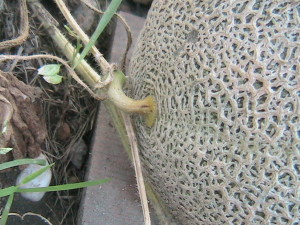
The part that connects to plant is turning brown. Soon it will come right off with very little effort or on its own. It is almost time to pick this cantaloupe.
Some can tell when they are ripe by hitting it with their finger and checking to hear what sound it makes. Others like to wait until the area where the vine connects to the fruit turns brown and comes off with a small push of the finger. I like this method because this way I just wait until it is no longer green and I won’t have to guess when it is ripe.
The Best Method for Beginners
The best method that is recommended is to look at the bottom of your fruit such as a watermelon and check to ground spot or the area where the fruit touches the ground. If this area has gone from a green color to orange, yellow, or gold then it is ripe for picking. All these methods work, but it is up to you to decide which one to use. You can even use all of them if you want!
Some Good Muskmelon and Cantaloupe Cultivars
Ambrosia hybrid
– has a resistance against powdery mildew and very sweet flavor.
Alaska
– For those that live in shorter summers this cultivar is for you.
Musketeer
– Sometimes fruits split for a various number of reasons and if you want to reduce the chances of this happening then this type is what you should be growing.
Chieftain
– This one is both disease and pest resistant and overall a good cultivar to grow.
Honeydew Cultivar that is Great for any Gardener:
Amber
– powdery mildew resistant and one of the larger types of honeydews to grow.
Watermelon Varieties
Charleston Gray
– perfect for people who have a problem with diseases and is resistant to many of the problems that melon gardeners face.
Carolina Cross
– prize winning watermelon that is capable of growing up to 200lbs!
Georgia Rattlesnake
– a reliable melon that is much easier to grow than many other cultivars available. I have been growing this one for a couple of years and it has produced a good crop each year. The one below is a Georgia Rattlesnake that weighed over 20 lbs.
Crimson Sweet
– This is another variety that can be grown in small backyards. Instead of oblong shape they are actually more round and still have a great sweet flesh for any occasion.


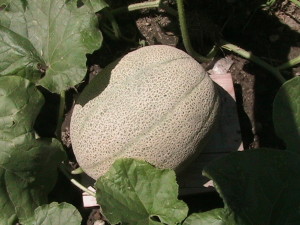
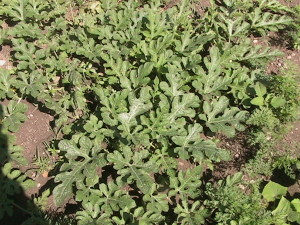
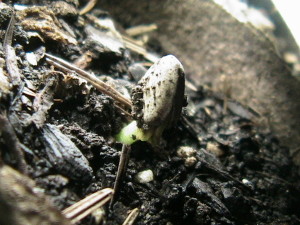
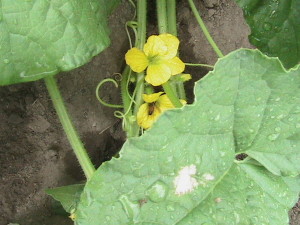



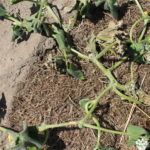
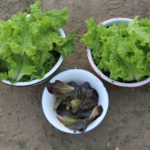

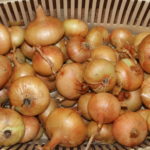
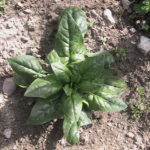
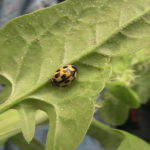
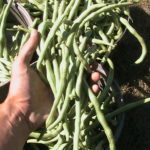
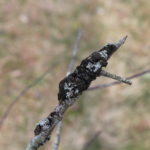
Recent Comments